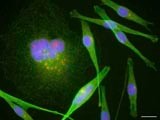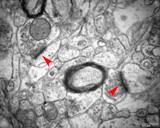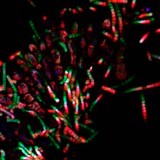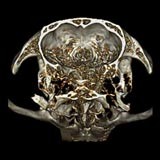Geoffrey Charters
Auckland Cancer Society Research Centre
School of Medical Sciences
"CONSTELLATION"
Fluorescence microscopy, using ACSRC Zeiss Axioskop 2. Human metastatic melanoma cell-line NZM2 grown on coverslip, fixed in paraformaldehyde and labeled for DNA (Hoechst 33342 (blue)), alpha tubuin (Alexa-fluor 488 (green)), and pericentrin, a centrosomal marker (Alexafluor 594 (red)). Antifade gold mountant.
Demonstrates centrosome numerical dysregulation, thought to be a primary cause of the generation of unstable ploidy in melanoma. In particular, the giant interphase polyploid cell contains at least 19 centrosomes. It has a distorted multi-lobed nuclear morphology, and there is a micronucleus at the bottom right of the centrosome cluster. Most of the other cells are relatively normal G1 cells, with regular nuclei and one centrosome, however at least one is aberrant, with a lobed nucleus and a cluster of perhaps 4 centrosomes. The patches of pericentrin staining associated with nuclei are enigmatic. They are suspected to be nucleolar from limited confocal data, but may be nuclear membrane associated. This could relate to a reported role for pericentrin in nuclear pore structure.





